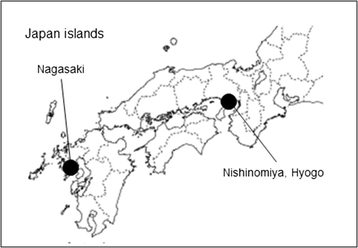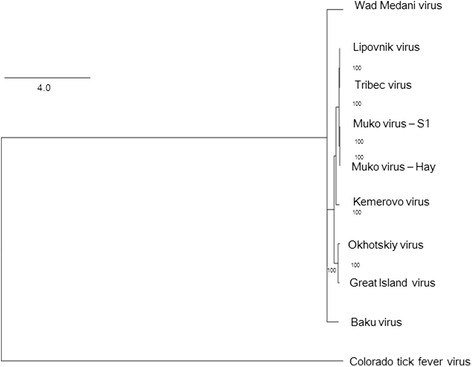Pathogenic potential and growth kinetics of Muko virus in mice and human-derived cells
- PMID: 27777508
- PMCID: PMC5057483
- DOI: 10.1186/s41182-016-0032-7
Pathogenic potential and growth kinetics of Muko virus in mice and human-derived cells
Abstract
Background: Ticks have been long known as vectors of various pathogens, some of which can cause high fatality rates among infected individuals. Our enhanced tick surveillance around Nagasaki, Japan, led to the isolation and identification of a new strain of a recently identified Orbivirus, Muko virus (MUV). The orbiviruses have a wide host range, including humans, and is related to a spectrum of clinical outcomes. However, the zoonotic potential of some members of the genus, although reported, were not clearly elucidated. Hence, it is imperative to characterize newly isolated orbiviruses and investigate its ability to endanger public health.
Methods: In this study, we explored the in vivo pathogenicity of a newly isolated MUV strain (MUV-Hay) using a mouse model and demonstrated its growth kinetics in human-derived cells.
Results: Our results showed the ability of MUV-Hay to propagate in human neuronal and renal cells with some cytopathic effect. Furthermore, intracerebral inoculation of our new isolate caused high mortality in adult A129 mice.
Conclusion: Our study provided a first step to experimentally test the hypothesis, that MUV can replicate and produce cytopathic effect in human cells and demonstrate virulence in adult mice.
Keywords: Human-derived cells; Mouse model; Muko virus; Tick-borne virus.
Figures





Similar articles
-
Genetic and biological characterization of Muko virus, a new distinct member of the species Great Island virus (genus Orbivirus, family Reoviridae), isolated from ixodid ticks in Japan.Arch Virol. 2015 Dec;160(12):2965-77. doi: 10.1007/s00705-015-2588-7. Epub 2015 Sep 8. Arch Virol. 2015. PMID: 26350980
-
Characterization of Novel Reoviruses Wad Medani Virus (Orbivirus) and Kundal Virus (Coltivirus) Collected from Hyalomma anatolicum Ticks in India during Surveillance for Crimean Congo Hemorrhagic Fever.J Virol. 2019 Jun 14;93(13):e00106-19. doi: 10.1128/JVI.00106-19. Print 2019 Jul 1. J Virol. 2019. PMID: 30971476 Free PMC article.
-
Isolation and characterization of Kabuto Mountain virus, a new tick-borne phlebovirus from Haemaphysalis flava ticks in Japan.Virus Res. 2018 Jan 15;244:252-261. doi: 10.1016/j.virusres.2017.11.030. Epub 2017 Nov 29. Virus Res. 2018. PMID: 29197549
-
[Tick borne zoonosis: selected clinical and diagnostic aspects].Parassitologia. 2004 Jun;46(1-2):109-13. Parassitologia. 2004. PMID: 15305697 Review. Italian.
-
Transfusion-transmitted tick-borne infections: a cornucopia of threats.Transfus Med Rev. 2004 Oct;18(4):293-306. doi: 10.1016/j.tmrv.2004.07.001. Transfus Med Rev. 2004. PMID: 15497129 Review.
References
-
- Davies CR, Jones LD, Nuttall PA. Experimental studies on the transmission cycle of Thogoto virus, a candidate orthomyxovirus, in Rhipicephalus appendiculatus. Am J Trop Med Hyg. 1986;35(6):1256–1262. - PubMed
-
- Takahashi T, Maeda K, Suzuki T, Ishido A, Shigeoka T, Tominaga T, Kamei T, Honda M, Ninomiya D, Sakai T, et al. The first identification and retrospective study of severe fever with thrombocytopenia syndrome in Japan. J Infect Dis. 2014;209(6):816–827. doi: 10.1093/infdis/jit603. - DOI - PMC - PubMed
LinkOut - more resources
Full Text Sources
Other Literature Sources
